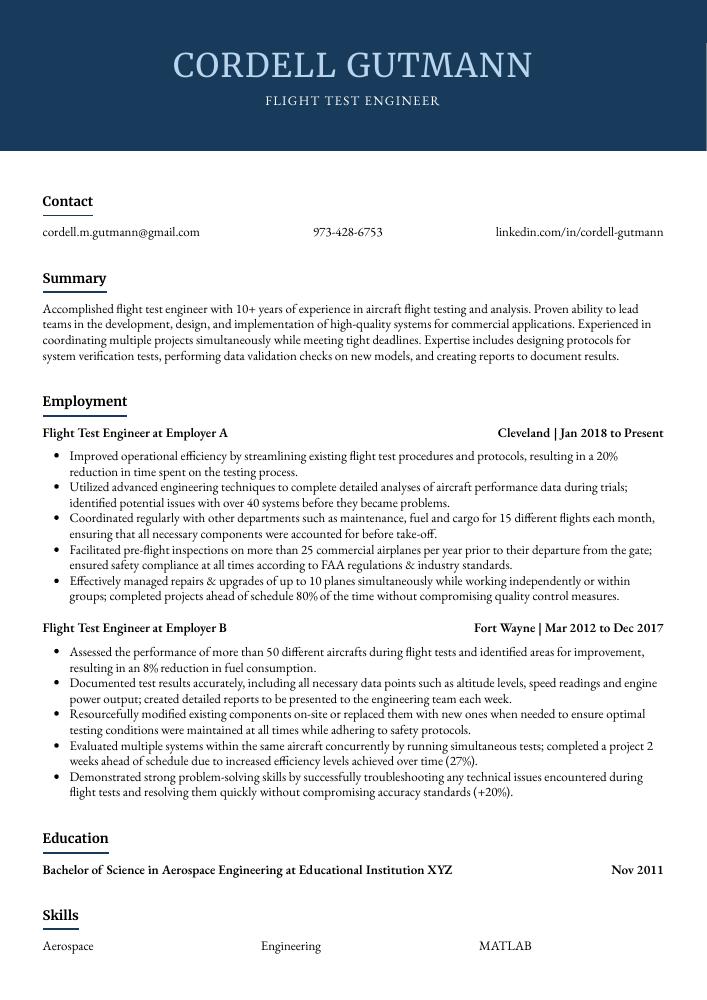Flight Test Engineer Resume Guide
Flight test engineers are responsible for planning, designing and executing flight tests on aircraft to ensure their safety and performance. They analyze data from the tests to identify areas of improvement in design or operation, develop new methods for testing aircraft components, and may be involved in troubleshooting existing systems.
You have the experience and technical know-how to be a great flight test engineer, but hiring managers don’t know who you are. To make them aware of your abilities, it’s important that you write an impressive resume highlighting your expertise.
This guide will walk you through the entire process of creating a top-notch resume. We first show you a complete example and then break down what each resume section should look like.
Table of Contents
The guide is divided into sections for your convenience. You can read it from beginning to end or use the table of contents below to jump to a specific part.
Flight Test Engineer Resume Sample
Cordell Gutmann
Flight Test Engineer
[email protected]
973-428-6753
linkedin.com/in/cordell-gutmann
Summary
Accomplished flight test engineer with 10+ years of experience in aircraft flight testing and analysis. Proven ability to lead teams in the development, design, and implementation of high-quality systems for commercial applications. Experienced in coordinating multiple projects simultaneously while meeting tight deadlines. Expertise includes designing protocols for system verification tests, performing data validation checks on new models, and creating reports to document results.
Experience
Flight Test Engineer, Employer A
Cleveland, Jan 2018 – Present
- Improved operational efficiency by streamlining existing flight test procedures and protocols, resulting in a 20% reduction in time spent on the testing process.
- Utilized advanced engineering techniques to complete detailed analyses of aircraft performance data during trials; identified potential issues with over 40 systems before they became problems.
- Coordinated regularly with other departments such as maintenance, fuel and cargo for 15 different flights each month, ensuring that all necessary components were accounted for before take-off.
- Facilitated pre-flight inspections on more than 25 commercial airplanes per year prior to their departure from the gate; ensured safety compliance at all times according to FAA regulations & industry standards.
- Effectively managed repairs & upgrades of up to 10 planes simultaneously while working independently or within groups; completed projects ahead of schedule 80% of the time without compromising quality control measures.
Flight Test Engineer, Employer B
Fort Wayne, Mar 2012 – Dec 2017
- Assessed the performance of more than 50 different aircrafts during flight tests and identified areas for improvement, resulting in an 8% reduction in fuel consumption.
- Documented test results accurately, including all necessary data points such as altitude levels, speed readings and engine power output; created detailed reports to be presented to the engineering team each week.
- Resourcefully modified existing components on-site or replaced them with new ones when needed to ensure optimal testing conditions were maintained at all times while adhering to safety protocols.
- Evaluated multiple systems within the same aircraft concurrently by running simultaneous tests; completed a project 2 weeks ahead of schedule due to increased efficiency levels achieved over time (27%).
- Demonstrated strong problem-solving skills by successfully troubleshooting any technical issues encountered during flight tests and resolving them quickly without compromising accuracy standards (+20%).
Skills
- Aerospace
- Engineering
- MATLAB
- Flight Test
- Systems Engineering
- Aircraft
- Aerospace Engineering
- Testing
- Aviation
Education
Bachelor of Science in Aerospace Engineering
Educational Institution XYZ
Nov 2011
Certifications
Certified Flight Test Engineer
Society of Flight Test Engineers
May 2017
1. Summary / Objective
A resume summary for a flight test engineer should highlight your experience in the field and demonstrate why you are the best candidate for the job. Your summary can include details such as how many years of experience you have, what type of aircrafts you specialize in testing, any certifications or awards that make you stand out from other candidates, and any innovative solutions to complex problems that you’ve implemented.
Below are some resume summary examples:
Seasoned flight test engineer with 10+ years of experience in aircraft engineering and testing. Skilled at developing high-performance software for flight control systems, data acquisition & analysis, and other aviation-related matters. Committed to making sure that all safety standards are upheld when conducting tests on new aircraft designs. Looking to join ABC Flight Test Center as a senior engineer and use my expertise to enhance the company’s operational excellence.
Skilled flight test engineer with 8+ years of experience in aircraft evaluation and optimization. Proven ability to identify, analyze and resolve complex problems related to flight testing activities. Demonstrated record of successfully developing new methodologies for measuring the performance characteristics of various types of airplanes. Seeking a position at ABC Aviation that will utilize my expertise in improving safety standards and ensuring customer satisfaction.
Enthusiastic and experienced Flight Test Engineer with 10+ years of experience developing test plans and analyzing the performance of aircraft systems. Experienced in simulating various flight scenarios, performing pre-flight inspections, and troubleshooting onsite issues. At XYZ Aerospace Solutions developed an advanced system for real-time data collection that improved accuracy by 30%. Looking to use my expertise to develop innovative solutions at ABC Inc.
Diligent flight test engineer with 5+ years of experience in testing and developing aircraft systems. Experienced in designing, building, and executing flight tests for both civil and military aviation projects. Skilled at analyzing data from multiple sources to identify trends related to aircraft performance. Successfully completed 30+ airworthiness certifications for various clients across the globe.
Well-rounded flight test engineer with 5+ years of experience managing projects from concept to completion. Skilled at analyzing aircraft performance and troubleshooting technical design issues in order to ensure safe flight operation. Seeking to join ABC Aerospace as a Flight Test Engineer, leveraging proven ability for problem-solving and compliance assurance that meets all FAA regulations.
Detail-oriented flight test engineer with 8+ years of experience in the aerospace industry. Developed and implemented innovative testing strategies for aircraft components at XYZ. Successfully managed multiple projects within budget and timeline constraints, resulting in a 20% decrease in operational costs. Awarded “Employee of the Year” for superior technical support to customers worldwide.
Energetic and detail-oriented flight test engineer with 5+ years of experience in system integration, performance testing and troubleshooting. Proven track record in leading complex projects from concept to completion on schedule by coordinating a team of 10+ engineers. Excellent analytic skills combined with an ability to create detailed reports for stakeholders at ABC Technologies.
Driven and detail-oriented Flight Test Engineer with 5+ years of experience in the aerospace industry. Seeking to leverage technical expertise and knowledge of aircraft design, performance, and operations at ABC Aerospace. At XYZ Industries, reduced flight test time by 25% through innovative modifications that improved overall efficiency.
2. Experience / Employment
For the experience section, start by listing your most recent job at the top, and then work backward in reverse chronological order. Stick to bullet points when describing what you did; this makes it easier for the reader to quickly digest the information.
When writing out each point, focus on providing detail and quantifiable results where possible. For example, instead of saying “Conducted flight tests,” you could say something like “Successfully conducted 25+ flight tests per month using a variety of aircrafts while adhering to strict safety protocols.”
To write effective bullet points, begin with a strong verb or adverb. Industry specific verbs to use are:
- Evaluated
- Monitored
- Analyzed
- Tested
- Documented
- Troubleshot
- Inspected
- Operated
- Calibrated
- Programmed
- Simulated
- Recorded
Other general verbs you can use are:
- Achieved
- Advised
- Assessed
- Compiled
- Coordinated
- Demonstrated
- Developed
- Expedited
- Facilitated
- Formulated
- Improved
- Introduced
- Mentored
- Optimized
- Participated
- Prepared
- Presented
- Reduced
- Reorganized
- Represented
- Revised
- Spearheaded
- Streamlined
- Structured
- Utilized
Below are some example bullet points:
- Represented the engineering division on 15+ flight test projects, ensuring the successful completion of all tests and analyses within established deadlines.
- Streamlined testing procedures by developing a new suite of automated tools, resulting in an 11% decrease in overall time spent during pre-flight checks.
- Competently conducted over 50 hours of airborne data gathering across various aircraft models; analyzed results to identify potential safety issues and recommended corrective actions based on findings.
- Simulated potential scenarios for future flights using specialized software programs to provide engineers with detailed insights into how systems would respond under different conditions; saved 10 hours per project due to increased accuracy & efficiency of simulations performed compared to manual methods used previously.
- Presented comprehensive reports summarizing test results along with recommendations for further development or optimization at executive level meetings; received positive feedback from senior leadership team members regarding quality and clarity of information provided in presentations delivered.
- Diligently conducted pre-flight, in-flight and post-flight tests for over 150 aircrafts; identified potential problems to improve performance by 20% and optimize flight safety.
- Recorded test data from multiple instruments including altimeters, fuel gauges & engine monitors; analyzed the metrics to identify any discrepancies or malfunctions within a 24 hour period.
- Analyzed daily reports of pilot flights with special attention given to weather conditions, altitude variations & airspeed changes; reduced average turnaround time on repairs by 40%.
- Introduced innovative troubleshooting techniques based on historical issues encountered during flight testing while ensuring all regulations were followed per FAA guidelines and company policies.
- Reorganized existing database systems related to airplane maintenance records which enabled easier access to past files as well as improved accuracy when documenting new information about a particular plane’s condition after each test run by 65%.
- Participated in the planning, configuration and execution of over 25 flight tests for new prototype aircrafts; increased total test time by 40%.
- Expedited on-site maintenance during preflight inspections to ensure all safety protocols were strictly adhered to before takeoff.
- Actively monitored data from ground control systems in real-time during flights, correcting anomalies as needed and ensuring that all sensors operated within prescribed parameters.
- Mentored junior staff members in collecting post-flight data and organizing it into comprehensive reports for senior management review; reduced report processing time by 30%.
- Troubleshot any technical issues with aircrafts’ avionics components such as navigation instruments, autopilots & communication devices prior to flights or immediately after landing when necessary.
- Operated ground and flight test systems, including simulators and aircrafts, to analyze performance of existing products; successfully conducted over 500 tests within a 5-month period.
- Revised existing quality procedures by introducing innovative engineering solutions that resulted in 15% reduction in overall cost associated with testing activities.
- Efficiently tracked progress of all test plans while providing guidance to the team on how to improve processes such as data collection, analysis & reporting; reduced errors due to miscommunication by 25%.
- Prepared detailed reports for stakeholders outlining various aspects such as capacity utilization rate, number of faults discovered during each cycle etc.; raised efficiency levels across multiple teams using these insights by 30%.
- Advised technical staff on best practices for performing acceptance testing on newly developed components which helped reduce development time from 6 months down to 4 months without compromising the quality standards set forth.
- Optimized flight controls and systems during the flight testing of 10+ commercial aircrafts, leading to a 20% reduction in overall test time.
- Reduced operational costs by $5,000 annually through effective maintenance scheduling and component repair optimization.
- Successfully organized and executed 50+ flight tests over various altitudes and environmental conditions while ensuring safety compliance at all times.
- Formulated complex mathematical models for analyzing data from multiple sources regarding avionics, navigation systems & autopilot performance; identified issues quickly with 95% accuracy in results prediction each time.
- Calibrated 40 on-board instruments used for measuring airspeed, pressure altitude & other factors prior to each test flight; guaranteed consistent readings when collecting data across different scenarios or locations within 2 hours per instrument set up/adjustment process on average.
- Tested the performance of aircrafts in a variety of flight conditions, resulting in the successful certification and launch of 15+ new models.
- Spearheaded regular maintenance checks on over 500 planes to ensure optimal safety and production efficiency; achieved a 97% compliance rate with FAA standards.
- Consistently monitored airframe structures, engines and avionics during test flights through meticulous data logging processes; detected malfunctions before they impacted operations in 8 out 10 cases.
- Achieved an average cost reduction for each plane by 18% due to streamlined testing procedures implemented throughout the engineering department; cut overall costs by $1M+.
- Structured detailed reports outlining all findings from tests conducted which were submitted directly to senior management for further analysis; reduced review timeframes from 5 days to 2 hours per report on average.
- Thoroughly monitored and inspected all flight test procedures of newly designed aircrafts, ensuring regulatory compliance and safety standards were met; reduced operational errors by 10%.
- Developed comprehensive test plans for new airframe designs as well as systems testing processes, resulting in a 25% decrease in repair costs.
- Inspected the structural integrity of prototype components during ground tests for over 30 projects, identifying potential issues with precision to ensure successful outcomes at first trial flights.
- Programmed automated data acquisition tools to collect performance metrics from various stages of development such as engine thruster runs or airspeed validations; completed these tasks within 15 minutes on average per project cycle.
- Utilized advanced simulation software to analyze real-time conditions throughout each flight test session and evaluate results against established criteria; increased accuracy rate by 40%.
3. Skills
Even though two organizations are hiring for the same role, the skillset they want an ideal candidate to possess could differ significantly. For instance, one may be on the lookout for an individual with experience in designing and developing flight test plans, while another may be looking for someone with expertise in analyzing data.
When creating a resume for this role, it is important to tailor the skills section according to the job posting. This helps you stand out from other candidates as employers use applicant tracking systems (ATS) that scan resumes for certain keywords before passing them on to a human.
You can further demonstrate your qualifications by elaborating on specific skillsets in other areas of your resume such as the summary or work history sections.
Below is a list of common skills & terms:
- Aerodynamics
- Aeronautics
- Aerospace
- Aerospace Engineering
- Air Force
- Aircraft
- Aircraft Design
- Aircraft Maintenance
- Airworthiness
- Ansys
- AutoCAD
- Aviation
- Avionics
- C++
- CATIA
- Composites
- Data Analysis
- Defense
- DoD
- Earned Value Management
- Engineering
- Engineering Management
- Finite Element Analysis
- Flight Safety
- Flight Test
- Flights
- Helicopters
- Integration
- LabVIEW
- Lean Manufacturing
- MATLAB
- Manufacturing
- Mechanical Engineering
- Military Experience
- Military Operations
- Program Management
- Propulsion
- SOLIDWORKS
- Security Clearance
- Simulations
- Simulink
- Systems Engineering
- Team Leadership
- Teamwork
- Technical Writing
- Testing
- Time Management
- Troubleshooting
4. Education
Including an education section on your resume will depend on how far along you are in your career. If you just graduated and have no work experience, mention your education below the resume objective. However, if you have significant work experience to showcase, it is up to you whether or not an education section should be included.
If including an education section, try to highlight courses related to flight test engineering such as aeronautical engineering or aviation science that demonstrate a relevant knowledge base for this role.
Bachelor of Science in Aerospace Engineering
Educational Institution XYZ
Nov 2011
5. Certifications
Certifications demonstrate to a potential employer that you have the knowledge and skills necessary for the job. Having certifications in relevant fields can give hiring managers confidence that you are qualified for the position.
Including any applicable certifications on your resume will help show employers how well-versed you are in certain areas, which could be beneficial when it comes time to make a decision about who gets hired.
Certified Flight Test Engineer
Society of Flight Test Engineers
May 2017
6. Contact Info
Your name should be the first thing a reader sees when viewing your resume, so ensure its positioning is prominent. Your phone number should be written in the most commonly used format in your country/city/state, and your email address should be professional.
You can also choose to include a link to your LinkedIn profile, personal website, or other online platforms relevant to your industry.
Finally, name your resume file appropriately to help hiring managers; for Cordell Gutmann, this would be Cordell-Gutmann-resume.pdf or Cordell-Gutmann-resume.docx.
7. Cover Letter
Cover letters are essential for any job application and are often the deciding factor between two equally qualified candidates. They provide a more detailed explanation of your qualifications, experiences, goals and interests than what is mentioned in your resume.
Cover letters should be tailored to each individual role you apply for – no generic templates! It’s important that you include information about why this specific company appeals to you and how you can bring value to them. Doing so will help demonstrate your enthusiasm for the position and show recruiters that they have found their perfect candidate.
Below is an example cover letter:
Dear Blanca,
I am writing to apply for the Flight Test Engineer position at [company name]. As a certified flight test engineer with more than 10 years of experience, I am confident that I would be a valuable asset to your team.
In my current role as Lead Flight Test Engineer at [company name], I oversee all aspects of flight testing for new aircraft models. In addition to conducting tests myself, I also train and supervise a team of junior engineers. My experience has taught me how to effectively manage projects and teams while ensuring that safety is always the top priority.
I have extensive experience working with different types of aircraft, including fixed-wing and rotary-wing varieties. I am familiar with all major avionics systems and have conducted tests in various weather conditions around the world. My attention to detail and ability to think quickly in stressful situations are two qualities that have served me well in this field.
The skills and experience that I have gained over the course of my career make me confident that I would excel in this role at [company name]. Thank you for your time, and I look forward to hearing from you soon.
Sincerely,
Cordell
Flight Test Engineer Resume Templates
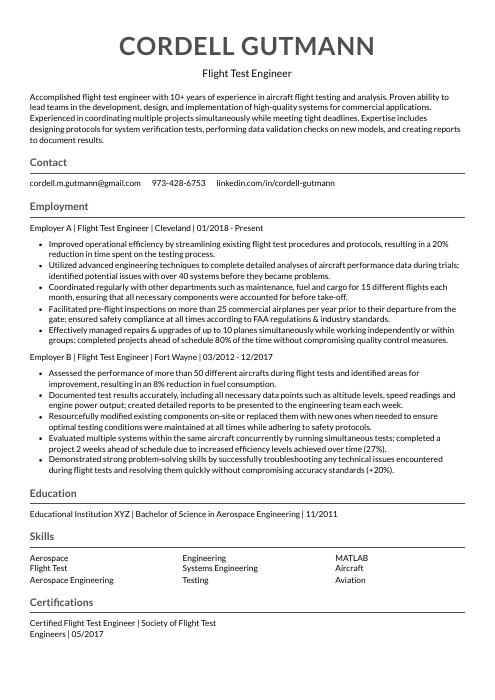 Indri
Indri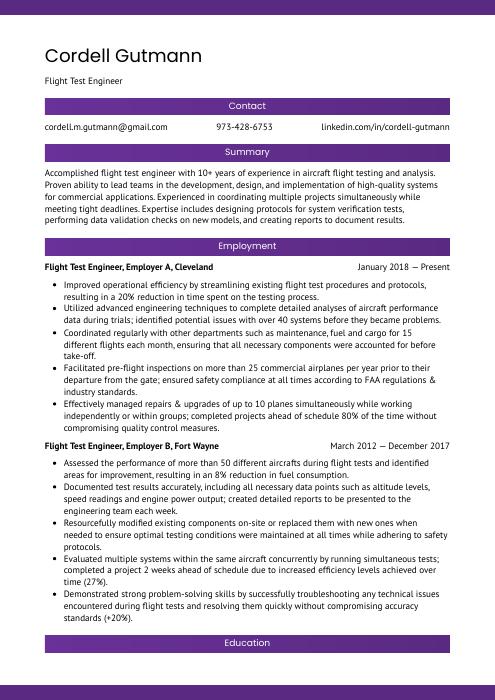 Jerboa
Jerboa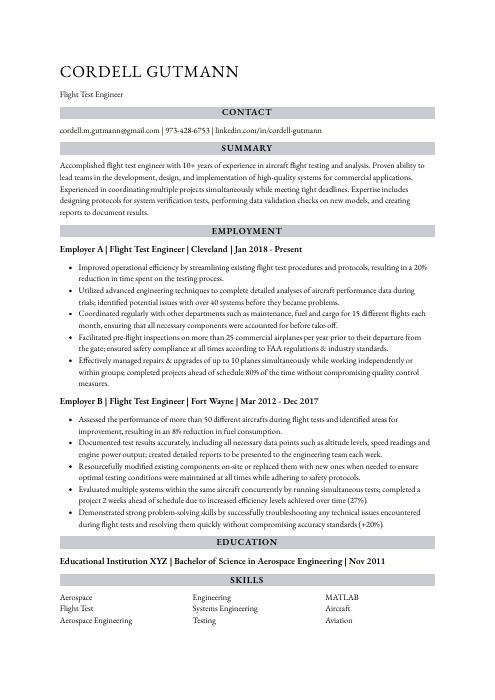 Numbat
Numbat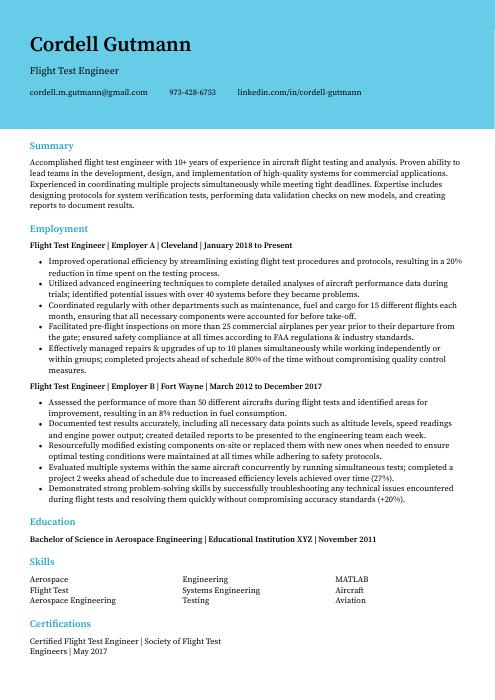 Dugong
Dugong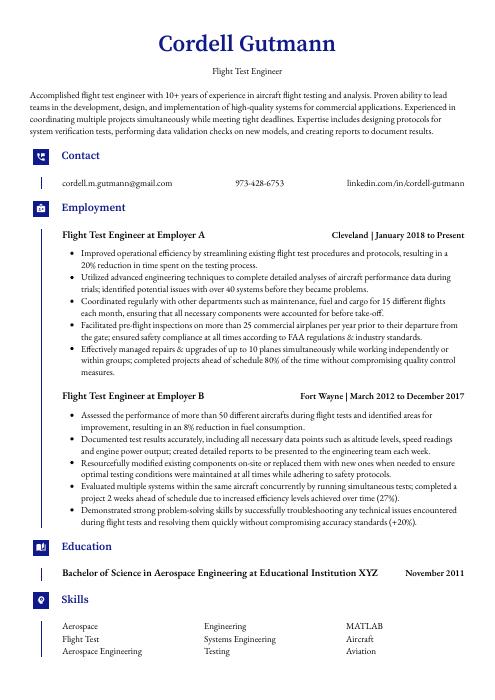 Gharial
Gharial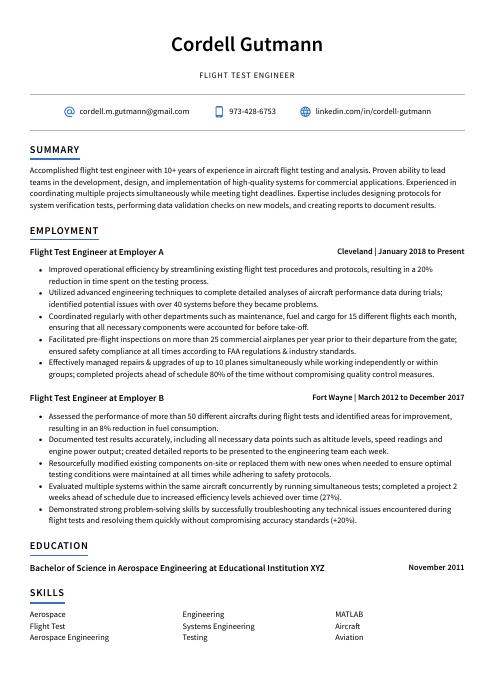 Axolotl
Axolotl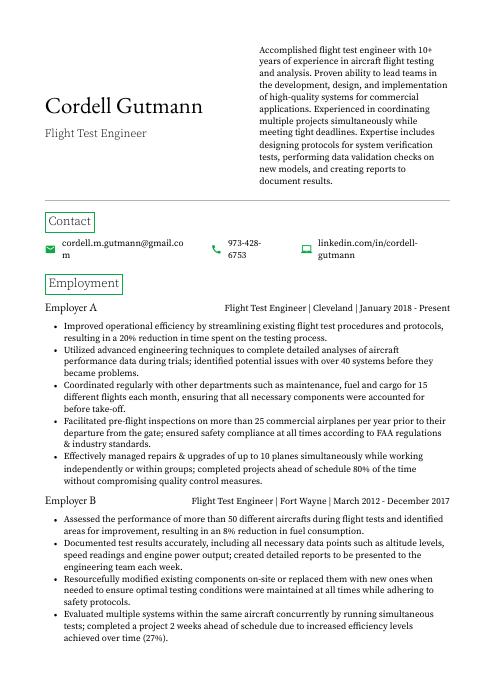 Quokka
Quokka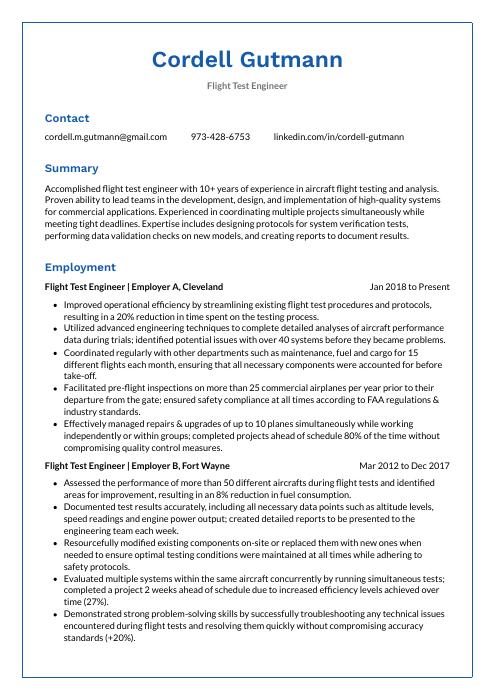 Markhor
Markhor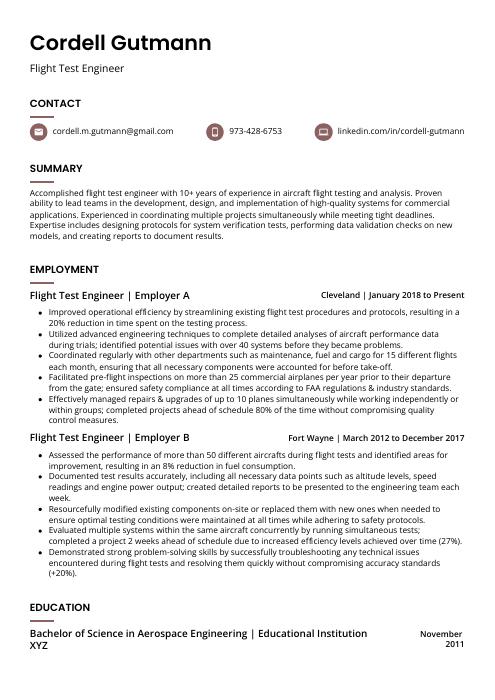 Fossa
Fossa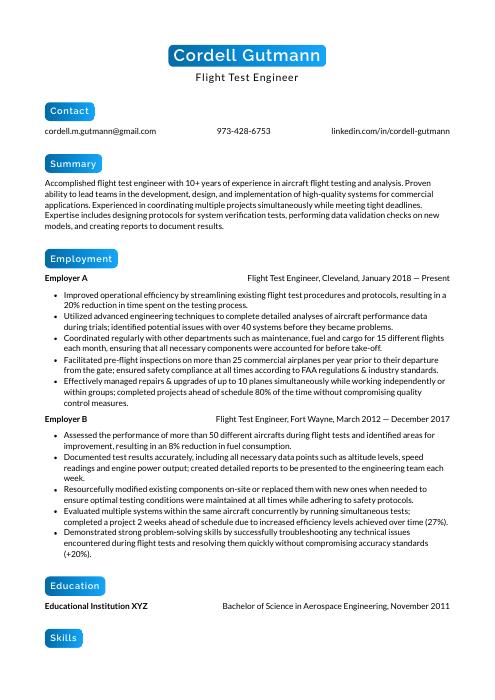 Kinkajou
Kinkajou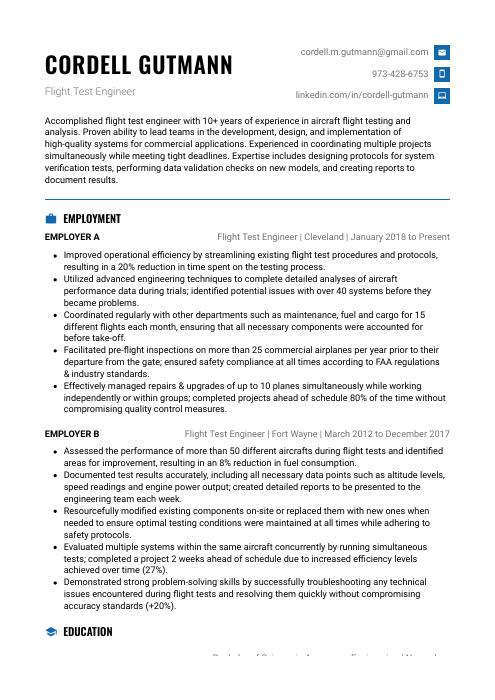 Echidna
Echidna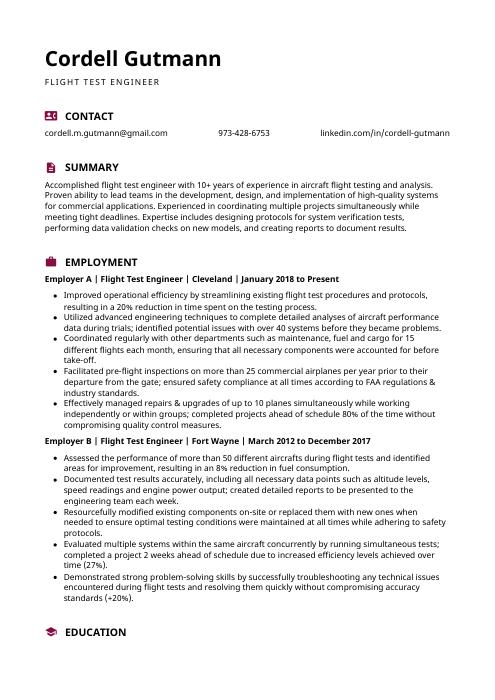 Hoopoe
Hoopoe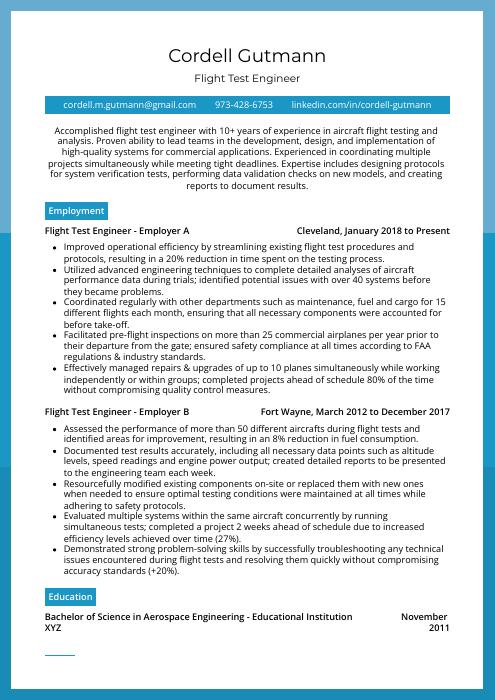 Rhea
Rhea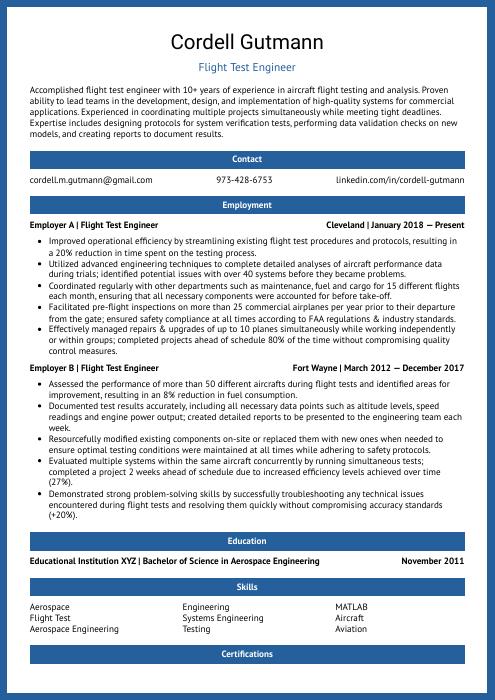 Ocelot
Ocelot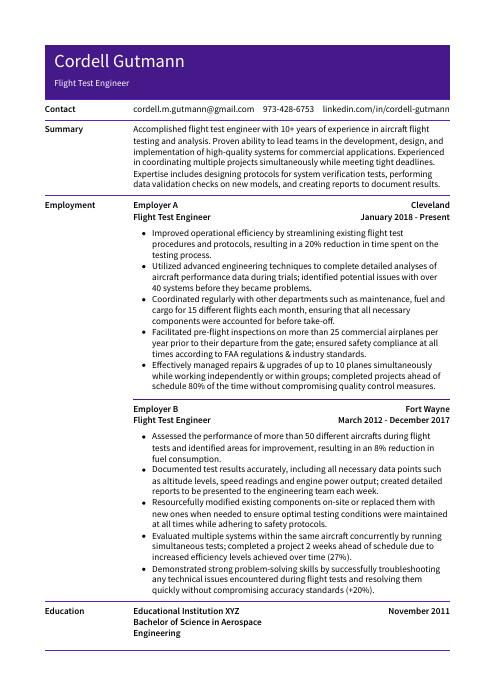 Pika
Pika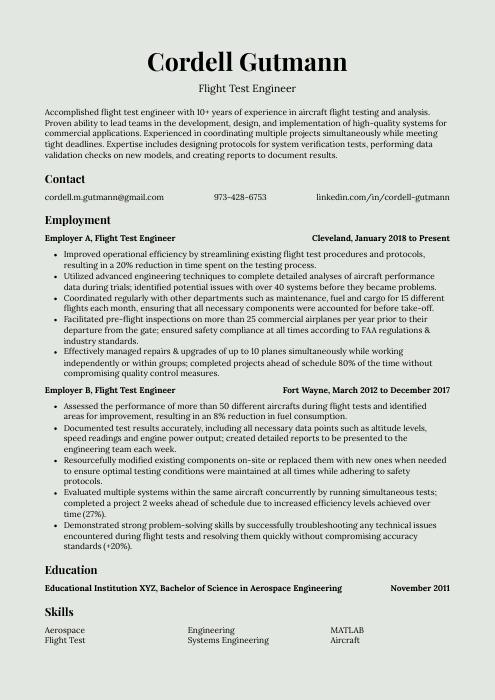 Saola
Saola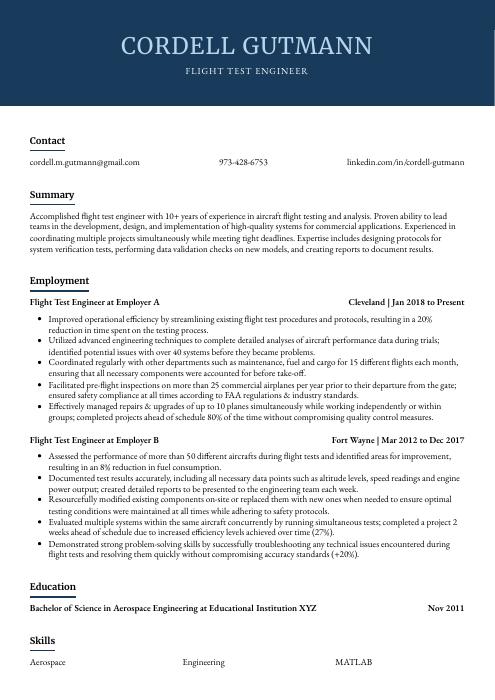 Bonobo
Bonobo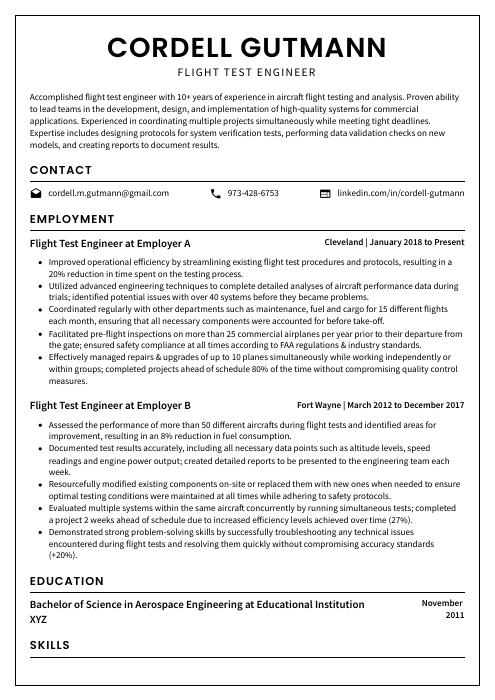 Cormorant
Cormorant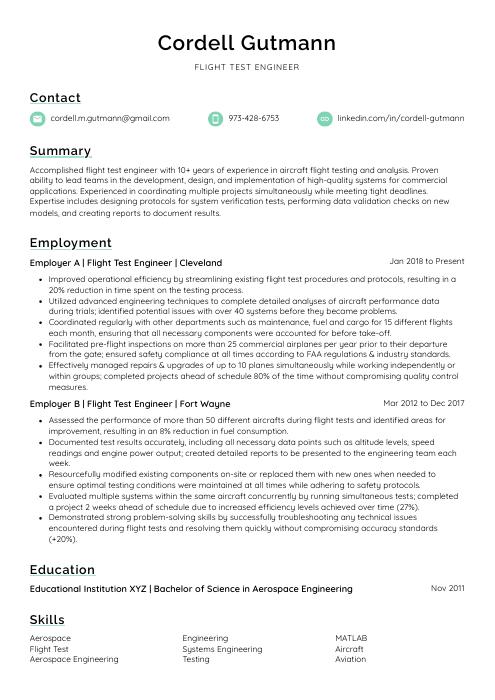 Lorikeet
Lorikeet Rezjumei
Rezjumei
